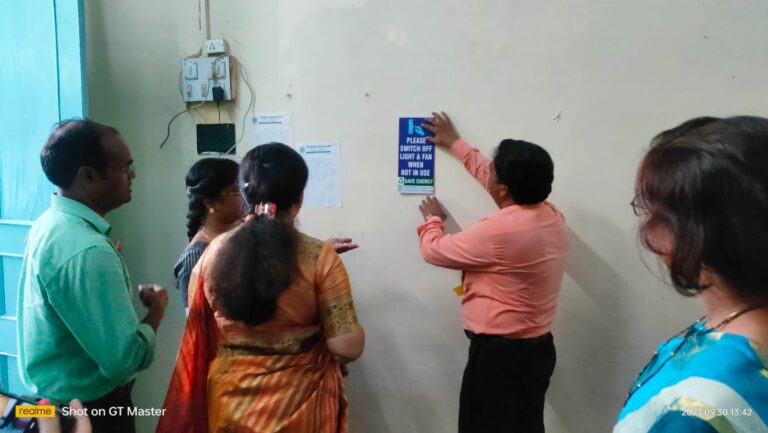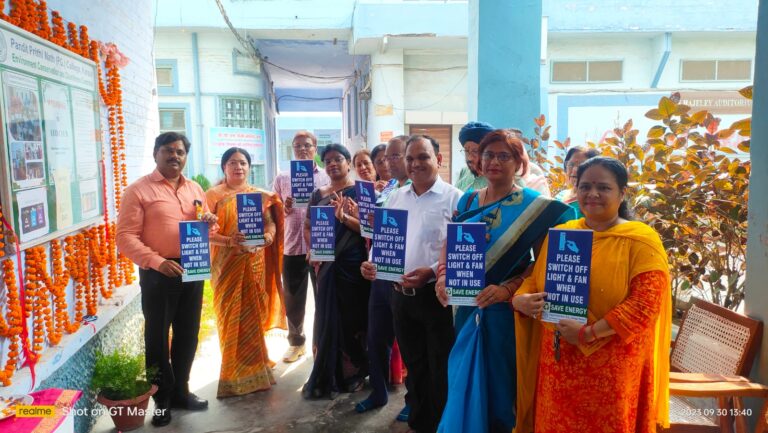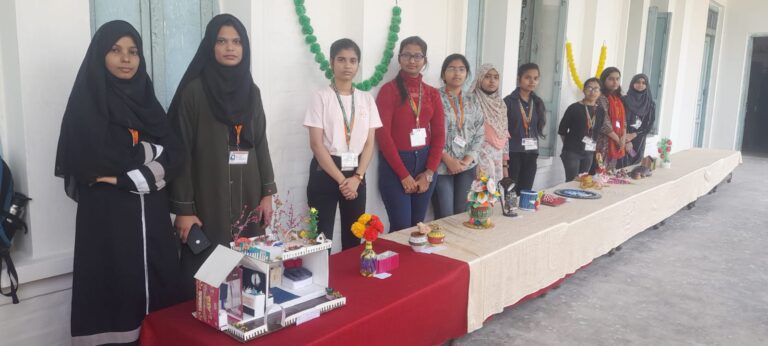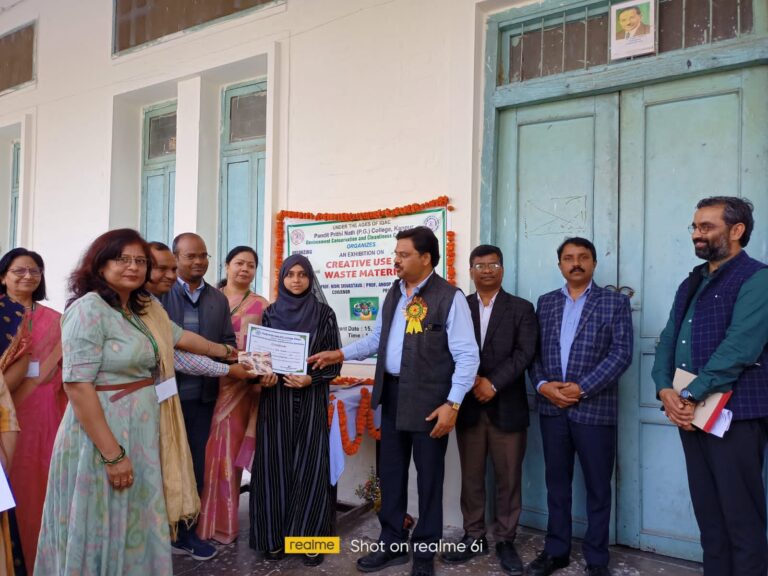




Environmental Consciousness
Objectives of the Practice:
The goal of the Environmental Consciousness Initiative’s of our college is to encourage a sustainable and environmentally conscious culture among the staff, professors, and students. We hope to raise awareness of environmental issues and encourage responsible activities that help preserve the resources of our planet through this practice. Our key goals include:
- To provide the campus community with information on environmental issues such as pollution, resource depletion, and climate change.
- Resource conservation refers to putting policies in place to lower trash production, water use, and energy consumption on campus. In order to reduce our ecological impact, this entails implementing energy-efficient technologies, water conservation measures, and garbage recycling programs.
- Green infrastructure refers to the implementation of sustainable practices, such as the use of eco-friendly materials, energy-efficient structures, and green spaces into campus infrastructure. The creation of a physical environment that adheres to the concepts of environmental consciousness is the goal of this objective.
- Community engagement refers to take an active role in environmental projects, forming alliances with nearby communities to carry out cooperative initiatives that advance environmental sustainability and enhance the ecosystem.
The Context:
Our college launched an Environmental Consciousness Initiative as a transformative response to the growing environmental concerns facing the world. The present environmental conditions emphasizes how urgent it is that we embrace sustainable practices in every aspect of our lives. The goal of the Environmental Consciousness Initiative is to make our campus a living laboratory for sustainability by incorporating sustainable practices into its culture.
This effort recognizes that educational institutions have a unique role in shaping social attitudes and habits, and it is in line with both local environmental priorities and larger global sustainability goals. Through promoting environmentally conscious practices, resource conservation, and community involvement, our college hopes to make a significant contribution to the ongoing efforts to lessen the effects of human activity on the environment.
The Practice:
Carpooling Initiative:
The faculty carpooling project is a trailblazing approach that tackles important issues including traffic congestion, environmental sustainability, and community engagement. A mutual understanding signed by faculty members who understood the urgent need to lessen the negative effects of individual commuter habits, served as the catalyst for this innovative project.
Faculty members voluntarily organize carpool groups and share rides to and from the college as part of this practice. In the context of Indian higher education, where academic members typically commute alone, this collaborative approach is exceptional.
Go Green, Go Cycling Campaign:
Bicycling on campus is encouraged via the “Go Green Go Cycle” campaign, which supports environmentally responsible transportation. Cycling lanes with markings, bike-sharing stations, and awareness campaigns all promote cycling as a sustainable form of transportation. This program offers an alternative to motorized transportation and encourages a healthy lifestyle in addition to making the campus greener.( Link in K.I. 7.1.2)
Plant Exchange Initiative:
Our dedication to biodiversity and community involvement is personified by the Plant Exchange Club. By exchanging plants, staff and students make the campus more lively and environmentally diverse. Deepening one’s relationship to nature is encouraged through workshops on plant care and environmental sustainability. This project fosters a sense of environmental responsibility while also making our surrounds more beautiful, encouraging a greener and more peaceful living and learning environment. (Link in K.I. 7.1.2)
Program for Energy Conservation:
Our college has a thorough Power Conservation Program in place to actively promote energy saving. This initiative’s key components are energy-efficient appliances, smart lighting systems, and frequent awareness efforts. The campus community actively participates in reducing energy use by turning off lights and other devices when not in use. Our college is positioned as a leader in responsible energy use because to our commitment to power conservation, which goes beyond individual habits to include sustainable methods in academic and administrative facilities. (Link in K.I. 7.1.2)
Evidence of Success:
There was a noticeable decline in single-occupancy cars when the Carpooling Initiative took off. As more people chose to travel together, carbon emissions significantly decreased, and parking spots were used more effectively. Feedback from the survey indicated significant economic savings in addition to the environmental advantages and the promotion of a sense of community.
Cycling amongst the students has increased dramatically since the launch of the “Go Green Go Cycle” program. Surveys measuring health and well-being highlight the campaign’s dual benefits, as members physical health has improved in addition to its obvious environmental benefits.
With communal gardens sprouting up and lush greenery everywhere, the Plant Exchange Club has had a noticeable impact on the campus’s environmental quality. The response provided by participants highlights an increased consciousness of environmental issues, with many expressing a renewed interest in sustainable gardening techniques at home spaces.
Our Power Conservation Program’s effectiveness is based on a steady decline in energy usage. Significant energy savings have been achieved as a consequence of the campus community’s dedication to shutting off lights and electronic devices when not in use. Comparison may be seen in annexure 2
Problems Encountered and Resource Required:
Despite its significant effects, the Environmental Consciousness Initiative’s implementation has brought forth a number of difficulties that call for careful planning and resource allocation.
Long-term maintenance of awareness and participation proved difficult. Although there was a lot of initial enthusiasm, ongoing communication and creative engagement techniques were needed to keep the program moving forward and keep it from becoming an afterthought.
Allocating resources effectively has become essential to the installation and upkeep of environmentally friendly infrastructure. Careful budgeting and wise resource allocation were necessary to get funding for projects like bike-sharing schemes and intelligent lighting systems.
Environmental Consciousness initiatives require funding for seminars, workshops, and awareness campaigns. Long-term success depends critically on financial investments for the creation and upkeep of sustainable infrastructure, community participation programs such as the Plant Exchange Club, and technology advancements for energy conservation.
To ensure the long-term success of our Environmental Consciousness Initiative, we must handle these difficulties holistically, integrating financial support, community involvement, and ongoing education.
Notes:
With the help of a number of best practices, our college has led a revolutionary project called the Environmental Consciousness Program that has completely changed the culture of our campus. Our Carpooling Initiative is a leading initiative that promotes carpooling among students and staff. This initiative helps to reduce the number of single-occupancy vehicles and builds a sense of community.
The “Go Green Go Cycle” program, which promotes cycling as a sustainable form of transportation, balances this out. This program has improved our community’s general health and well-being in addition to lowering carbon emissions thanks to bike-sharing stations and designated bike lanes.
The founding of the Plant Exchange Club has fostered a lively environmental consciousness. This club encourages members to trade plants with one another, which improves campus aesthetics and strengthens ties to the natural world.
Our Power Conservation Program has promoted energy efficiency throughout the campus in addition to these. Energy usage has significantly decreased because of smart lighting systems, energy-efficient appliances, and community-wide awareness programs, demonstrating our dedication to a sustainable future.
Together, these best practices highlight our commitment to environmental stewardship and promote a comprehensive understanding of sustainability among our college community’s members. We hope that by implementing these efforts, staff, teachers, and students will not only contribute to a greener campus but also develop a lifelong awareness of environmental issues.

